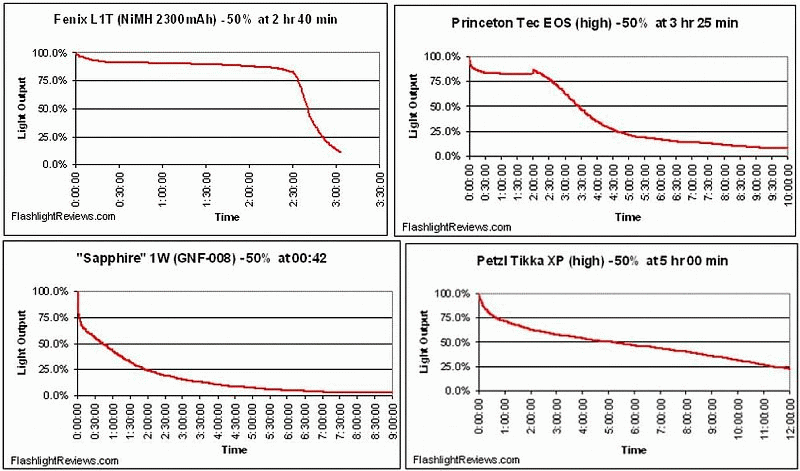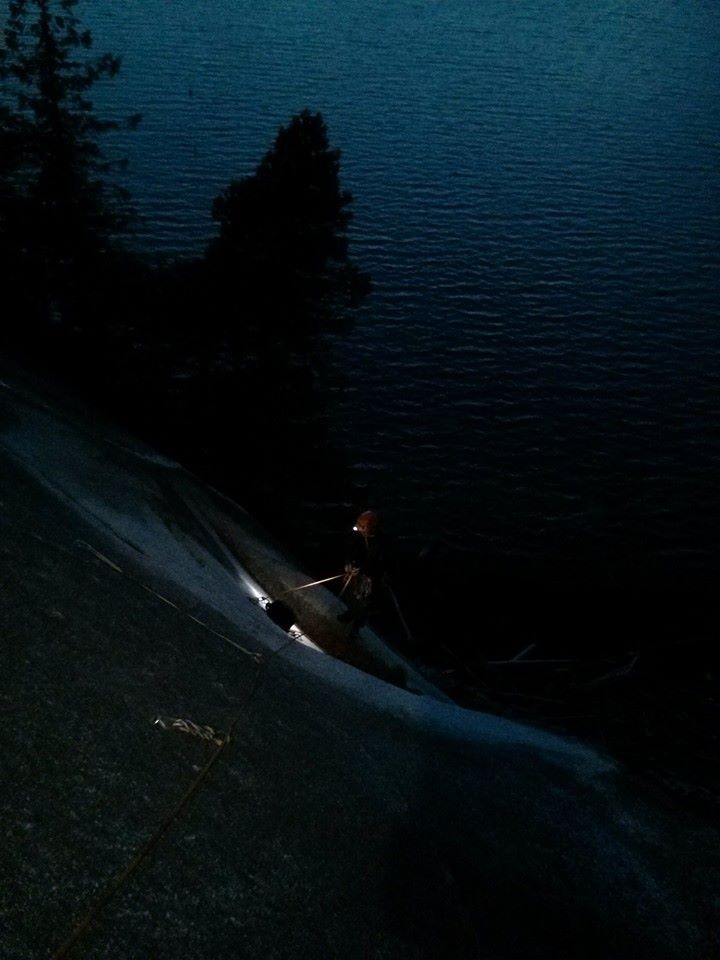Best headlamp under $50?
|
|
Plus a Energizer headlamp and Kinco gloves give you that hardman look |
|
|
gearx.com/black-diamond-spo…
29.97 for 2015 Spot 130 Lumens gearx.com/black-diamond-cos… 21.97 for 2015 Cosmo 90 lumens |
|
|
@ DRusso - Great find, thanks for sharing. |
|
|
+1 ^^ Don't forget active-junky extra 10% cash back |
|
|
Used an Icon for years, was happy with it. Was pretty foolproof, and the one time I let batteries leak in the pack it was easy to clean. I liked having all AA battery gear. |
|
|
I love the Zebralight H52 . It runs best on a single AA rechargeable Enerloop battery with an illumination of 300 lumens on the maximum setting. The only weakness is that it only lasts for 0.9 hours on the max setting but up to 3 hours on the lowest setting. Zebralight H52 AA headlamp . However, it's easy to carry one or two spare batteries. I've only had to use the spare once over an extended 4 day trip. Most of my fellow climbers/hikers are envious of how bright this light is. Zebralight makes some other headlamps but I prefer the ones that can run on the single AA battery because of the ease of recharging them on a portable solar panel. |
|
|
Petzl Tikka XP2 w/LiIon rechargeable battery. The custom output software works very well and the light functions flawlessly. I recharge it from my computer or with phone chargers. |
|
|
Storm or Spot for sure |
|
|
I'm a big backpacker as well as climber, and I've had 4 different headlamps. Two failed (A BD spot, and a Petzl one) and I lost My BD Storm. I now use a Princeton Tec Vizz and it is by far the best of all of the ones I've used. Ridiculously bright at the max, but easily adjustable to make it less bright just by holding the button down if needed. Red light goes on with your first button press so you don't have to annoy people at night. Lock feature is easy and is almost impossible to unlock unintentionally. Low Battery indicator is obvious. I used it on the entire Appalachian Trail this year and it was perfect. A bit heavier than the competition because it uses 3 batteries and is pretty beefy, but its worth it to me. |
|
|
Agree with JayMorse, the Princeton Tec vizz is my preferred headlamp. The other lamp I still sometimes use is an old petzl Tikka that has held up to some serious abuse. |
|
|
I also went with the Coast partly off that review. It will run through batteries quicker but you can also adjust the brightness down very easily when you don't need the incredibly bright spot. I haven't had it turn on in my pack any more than any other lamp either. For alpine route finding on rock I couldn't be happier. I did find the headband tight when putting it on a helmet, but that was my only complaint. It's also incredibly light and compact. Pretty happy with it. |
|
|
I have a TON of headlamps, from your standards like BD, Petzl and PT as well as more cutting edge ones from the "Falshaholic" brands like Zebralight and Spark with the single AA ZL being my current favorite. |
|
|
Patrick Shyvers wrote:Used an Icon for years, was happy with it. Was pretty foolproof, and the one time I let batteries leak in the pack it was easy to clean. I liked having all AA battery gear. I'm really, really big on rechargeable batteries though, and I don't think the Icon was designed with them in mind. The brightness would tail off to pretty low levels within 6-8 hours with NiMH, even when I kept the output level down. Eventually I sold it. We'll see how the 2016 Spot turns out, but at first glance it appears to be the best of the 2015 Storm & Spot, rolled into one. I like that BD is being pretty aggressive about updating their headlamps with newer, brighter, more efficient LED tech. I'm inclined to support that with my wallet. I frequently carry extra lights so I'll be OK if my main light craps out- and I think that's a good practice whether you have a BD, a Petzl, or a MagLite.theres 2 things at work here - the icon is NOT a regulated headlamp ... which means that the light will start "dimming" as an example ... see if you can spot the "regulated" light - NiMH and alkalines have less energy ... and may have a "steeper curve" than lithiums .. which means that even with a unregulated headlamp, lithiums may actually behave somewhat "regulated" ... shove a NiMH or alkaline in there and they can dim or die quicker power curve for battery chemistries ... from energizer as a note ... if one is using the headlamp for extended activities where higher output is needed ... ie climbing all night ... the only real choice for the weight conscious climber is lithium ion ... anything disposable is out as youll be spending quite a bit every night ... and NiMH is 3-4 times heavier than LiOn for the same amount of energy if its a one time use or rarely used ... or yr sponsored with bats, then regular lithium will do when using a headlamp for extended periods at higher output battery weight FOR THE POWER PROVIDED is just as important as headlamp weight itself, if not more so as an example any good 18650 LiON headlamp absolutely blows away the BD Icon in terms of runtime AND output simply because instead of the battery weight the table below quite clearly shows the gram per energy watt hours (Wh) of various chemistries for those that need a refresher .... Because mobile electronics are so pervasive, it is important for users to understand how to compare batteries. While most people are familiar with, for example, “gigabytes” as a measure of hard drive space and have a more instinctive appreciation for phrases like “4G speeds,” the nomenclature used to gauge the amount of energy capcity in a battery is still a bit of a mystery. This is exacerbated by some outdated industry practices that are throwbacks to when a single battery technology dominated any given energy sector. Most companies use capacity measurements that aren’t consistent from one battery technology to the next. So how do you compare and choose your battery pack? We’ll try to unshroud some of the mystery here. How industry makes measuring battery capacity confusing Most products show battery capacity measured in “amp-hours” (Ah) and milliamp-hours (mAh), where 1000mAh = 1Ah. Amp-hours is a measure of “current capacity”, not “energy capacity”. This is a subtlety, but it is important. Amp-hours only tells half the capacity story. What is an amp-hour? An amp is a measure of electrical current, and the hour indicates the length of time that the battery can supply this current. A 2.2Ah battery can supply 2.2 amps for an hour. If the battery must supply more amps, because a bigger device is connected, it will last for a shorter period of time; if the battery is supplying less amps, it will last longer. The problem with this method is that it doesn’t give a complete picture of the total energy stored. It is easy to find cases where two different batteries with the same number of amp-hours will have completely different amounts of total energy. How Goal Zero measures battery capacity The correct unit for measuring energy capacity of a battery product is called watt-hours. Watt-hours signifies that a battery can supply an amount of watts for an hour. For example, a 60 watt-hour battery can power a 60 watt light bulb for an hour. The same battery would run a 5W phone for 12 hours and power a 1W LED light bulb for 60 hours. Watt-hours is a simple and consistent way to measure the capacity of any battery pack, whether it’s a Nickel Metal Hydride (NiMH), AA battery, the 12V lead acid battery in your car, or the lithium ion battery pack on your laptop. Goal Zero offers battery packs in all of these configurations, and they are easily comparable by looking at the watt-hours rated to each one. What is the difference between watt-hours (Wh) and amp-hours (Ah)? The equation for power is watts = amps x volts and for energy the equation is watt-hours = amp-hours x volts Amps is only half of the equation. Since different batteries may have different voltages, amp-hours is only useful for comparing products that have the same battery configuration. If you want to be sure that you’re getting the right results, use watt-hours for an apples-to-apples comparison. What if I don’t have watt-hours? To get a good grasp of the actual energy capacity, without access to the watt-hour rating of a pack, you can do a quick calculation to generate the watt-hours. First, find out the Ah rating of the battery pack (if it’s given in mAh, take that number and divide it by 1000 to get the Ah value). Second, find out the battery type or chemistry and then the typical voltage for that type. Here’s a short list of the most common types of batteries and their voltages: 3.7V per lithium-ion cell (cell phones use a single cell (3.7V), laptops typically use 3 cells in series (11.1V) 3.2V per lithium-ion iron phosphate cell (multi-cell LiFePO packs are typically configured as 4-cell or 12.8V) 1.5V per alkaline cell 1.2V per NiMH and NiCad cell 2.1V per lead-acid cell (car batteries are 6-cell (12.6V) and some golf carts are 3-cell (6.3V)) Finally, multiply the voltage (V) by the amp-hour (Ah) rating of the battery/pack to get watt-hours (Wh) and then compare. For example, the Switch 8 Solar Recharger is 3.6V and 2.2Ah (2200 mAh) By multiplying those two together you get 7.92W. Will the Switch 8 charge your iPhone? well, the iPhone 5 has a 1440 mAh (1.4Ah) battery at 3.7V for 5.18W — yes! goalzero.com/solarlife/2013… to put it simply mobile phones and laptops havent used NiMH in almost a decade ... why would you want to use it in a headlamp? ;) |
|
|
Perhaps because 18650, while a great battery, is still a red-headed stepchild? |
|
|
An 18650 in a headlamp for climbing is stupid. |
|
|
Ray Pinpillage wrote:An 18650 in a headlamp for climbing is stupid.youve obviously never used a good 18650 headlamp there ... youre puny little tikka xp2 (which i used to own years ago) wont light up the raps like this ... nor light up at 150 lm for 10 hours do you even do night climbing there buddy? ;) |
|
|
bearbreeder wrote: youve obviously never used a good 18650 headlamp there ... youre puny little tikka xp2 (which i used to own years ago) wont light up the raps like this ... nor light up at 150 lm for 10 hours do you even do night climbing there buddy? ;)I've got six lights that use 18650 batteries. For a climbing oriented headlamp its ridiculous. My "little" XP2 will run for over 20 hours and puts out more light than I need. The 18650 is physically too large and heavy for the application. For high speed applications where you out run your light, sure. Alpine climbing...stupid. Enjoy your coal miner's light. |
|
|
Ray Pinpillage wrote: I've got six lights that use 18650 batteries. For a climbing oriented headlamp its ridiculous. My "little" XP2 will run for over 20 hours and puts out more light than I need. The 18650 is physically too large and heavy for the application. For high speed applications where you out run your light, sure. Alpine climbing...stupid. Enjoy your coal miner's light.Hey there ray I didnt realize that you were so weak that you couldnt carry my 18650 headlamp up ... Hl55, rxp, tikka You DO realize that a single 18650 bat weights the same as 4 AAA eneloops ... Or 2 AAs ... Miso sowwy dats 2 HEEVY fur ya =P Oh and its nice that your little XP2 lasts for "20 hours" at basically the lowest setting My "heavy" 18650 last for 30 hours regulated at 50+ lm, u know the MAX output of yr xp2 heres one of my partners with a petzl XP ... note that its my RXP which is lighting him up, his XP was exceptionally lacking in comparison ... he has since went out and bought/used a 18650 lamp for alpine and multi since you dont climb at night anyways ... let me show you the difference between the RXP and the HL55 ... 215 vs 900 lm ... on a full 30m pitch ... the extra brightness is useful for finding those pesky rap anchors ... something youve never had to do at night since you dont climb anyways ... needless to say the XP2 doesnt even show up in the pics above .... i didnt bother its absolutely hilarious that yr whinning about basically 30-50 extra grams when yr the one dragging up 80+g benchmade knives ... ;) |
|
|
Look at those hurt feelings. |
|
|
Ray Pinpillage wrote:Look at those hurt feelings.awww ... poor babii ... is that all yr reduced to ... whining about "hurt feelings" you run off and call other folks STOOOPID and play the victim now =P its typical of your "posts" where you go out and attacks folks, dont provide any actual facsts or evidence ... and then just keep on attacking folks for yourself being wrong go play with your "heavy" benchmade knives which you drag up climbs there its pretty obvious you dont climb at night there and dont know anything about it ;) |

 Continue with onX Maps
Continue with onX Maps Continue with Facebook
Continue with Facebook































